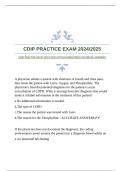CDIP PRACTICE EXAM 2024\2025
CDIP PRACTICE EXAM 2024\2025 WITH GUARANTEED ACCURATE ANSWERS
A physician admits a patient with shortness of breath and chest pain,
then treats the patient with Lasix, oxygen, and Theophylline. The
physician's final documented diagnosis for the patient is acute
exacerbation of COPD. What is missing from this diagnosis that would
make it reliable information in the treatment of this patient?
a.No additional information is needed.
b.The type of COPD
c.The reason the patient was treated with Lasix
d.The reason for the Theophylline - ACCURATE ANSWERS✔✔
If the physician does not document the diagnosis, the coding
professional cannot assume the patient has a diagnosis based solely on
a.An abnormal lab finding
,b.Abnormal pathology reports
c.Both A and B
d.None of the above - ACCURATE ANSWERS✔✔ c The coder cannot
assume diagnoses on abnormal findings such as lab reports. Abnormal
findings (laboratory, X-ray, pathologic, and other diagnostic results) are
not coded and reported unless the physician indicates their clinical
significance. If the findings are outside the normal range and the
physician has ordered other tests to evaluate the condition or prescribed
treatment, it is appropriate to ask the physician whether the diagnosis
should be added (AHA 1990, 15).
These documents would be used for are used by clinicians and providers
to identify abnormal temperature, blood pressure, pulse, respiration,
oxygen levels, and other indicators.
a.Nurses' graphic records
b.Vital sign flowsheets
c.Both A and B
d.None of the above - ACCURATE ANSWERS✔✔ c Clinicians and
providers utilize various documents to identify abnormal temperature,
blood pressure, pulse, respiration, oxygen levels, and other indicators.
These documents are often called nurses' graphic records or vital sign
flowsheets (Hess 2015, 43).
The American Hospital Association (AHA), the American Health
Information Management Association (AHIMA), Center for Medicare
and Medicaid Services (CMS), and National Center for Healthcare
Statistics (NCHS) are all
a.Cooperating parties
,b.Governing bodies
c.Coding associations
d.Work independently to develop coding guidelines - ACCURATE
ANSWERS✔✔ a The American Hospital Association (AHA), the
American Health Information Management Association (AHIMA),
Center for Medicare and Medicaid Services (CMS), and National Center
for Health Statistics (NCHS) are all cooperating parties that developed
and approved ICD-10-CM/PCS (ICD-10-CM Official Guidelines for
Coding and Reporting 2016a, 1).
A patient was admitted with HIV and pneumocystic carini. The patient
should have a principal diagnosis in ICD-10 of:
a.AIDS
b.Asymptomatic HIV
c.Pneumonia
d.Not enough information - ACCURATE ANSWERS✔✔ a If a patient
is admitted for an HIV-related condition, the principal diagnosis should
be B20, Human immunodeficiency virus [HIV] disease followed by
additional diagnosis codes for all reported HIV-related conditions (ICD-
10-CM Official Guidelines for Coding and Reporting 2016a, 17).
APR-DRGs have levels (subclasses) of severity entitled:
a.Excessive, Major, Moderate, Minor
b.Extreme, Major, Moderate, Minor
c.Extreme, Major, Moderate, Minimal
, d.Excessive, Major - ACCURATE ANSWERS✔✔ b The APR-DRG
system is distributed into levels (subclasses) similar to MS-DRGs. These
levels are entitled Extreme, Major, Moderate, Minor (Hess 2015, 48)
During an outpatient procedure for removal of a bladder cyst, the
urologist accidentally tore the urethral sphincter requiring an observation
stay. This should be assigned as the principal diagnosis:
a.The reason for the outpatient surgery
b.The reason for admission
c.Either the reason for the outpatient surgery or the reason for admission
d.None of the above - ACCURATE ANSWERS✔✔ a When a patient
presents for outpatient surgery and develops complications requiring
admission to observation, code the reason for the surgery as the first
reported diagnosis (reason for the encounter), followed by codes for the
complications as secondary diagnoses (ICD-10-CM Official Guidelines
for Coding and Reporting 2016a, 103).
In 1990, 3M created which DRG system that several states use for
Medicaid reimbursement and is also used by facilities to analyze some
portion of the data for Medicare Quality Indicators. What is this system
called?
a.MS-DRGs
b.AP-DRGs
c.APR-DRGs
d.CPT-DRGs - ACCURATE ANSWERS✔✔ c In 1990, 3M created
APR-DRGs, which several states use for Medicaid reimbursement.




